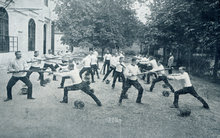kuk military fencing and gymnastics teacher institute
The kuk military fencing and gymnastics instructor institute in Wiener Neustadt was the central training facility of the Austro-Hungarian land and naval forces for instructors in fencing and gymnastics.
After the military central fencing school, which was built in the same place in 1852, was dissolved again in 1868, a shortage of trained fencing and gymnastics instructors at the military training institutions quickly arose. It was also not possible to remedy this deficiency without further ado, so that in 1881 the kuk military fencing and gymnastics instructor institute had to be set up.
Up until 1894, the training consisted only of a one-year normal course, which was then followed by four or five-month special courses from 1894.
Originally, saber and foil fencing was taught in the French manner at the institute . However, numerous improvements made by the fencing teachers over time resulted in a typically Austrian school. In 1895 the top Austrian army fencers met for the first time with Italian fencers at an international tournament in Prague . Impressed by the Italian fencing manner, the school, against certain opposition, sent first lieutenant Tenner and lieutenant of the line von Brosch to learn the Italian method from the fencing master Luigi Barbasetti in Vienna . The knowledge that the two gentlemen brought into the educational institution then became the basis of the high level of fencing in the Austro-Hungarian armed forces. The institute also closely followed the relevant sporting events in other countries and repeatedly sent active participants and visitors. Observer.
The most recently pursued goals of the institute were the introduction of Swedish gymnastics in the military educational institutions, modernization of the gymnastics regulations, issuing of new guidelines for bayonet fencing, as well as the introduction of football and athletics as a team sport in the armed forces.
Courses
The normal course had the task of training officers and non-commissioned officers of all branches to become military fencing and gymnastics instructors in order to ensure uniform training in the military training institutions and the troops. The frequenters were not allowed to be older than 30 years and had to be single and healthy. Aptitude for fencing and gymnastics and a preference for sport in general were required. The number of participants per course was around 25 officers and the same number of NCOs
In each of the two special courses, around 80 officers received qualified training in saber and bayonet fencing and gymnastics. The completed course led to the instructor for these disciplines in the troop.
Olympic Games 1912
The institute sent a team to the Olympic Games in Stockholm that could win a total of three medals. The first lieutenant Richard Verderber , who won a bronze medal (at that time also called 3rd place) in foil individual fencing and a silver medal in saber team fencing, did an excellent job .
The military fencing master Milan Neralić , who was an internationally recognized figure in the field of fencing, also stood out as a member of the institute .
Commanders of the institute
- 1881 to 1886: Retired Major Joseph Feldmann
- 1886 to 1887: Captain Gustav Igálffy von Igály
- 1887 to 1895: Lieutenant Colonel Oskar Schadeck von Degenburg
- 1895 to 1903: Colonel Alexander Ritter von Czajkowski
- 1903 to 1910: Colonel von Riegler
- 1910 Major Tenner
literature
- Verlag Siegfried Bergmann "The Wehrmacht of the Monarchy" Vienna 1913
- Regulation DE No. 66, gymnastics regulation for the infantry, 1910
Web links
- The k. and k. Military fencing and gymnastics teacher course in Wiener Neustadt, 1892 , e-book of the University Library Vienna ( e-books on demand )
- Guide for the officer to ensure success in a duel with the saber , 1904, e-book of the University Library Vienna ( e-books on demand )




